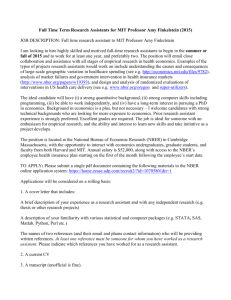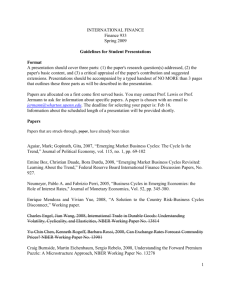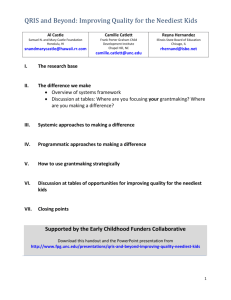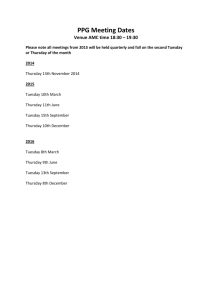Department of Economics
advertisement
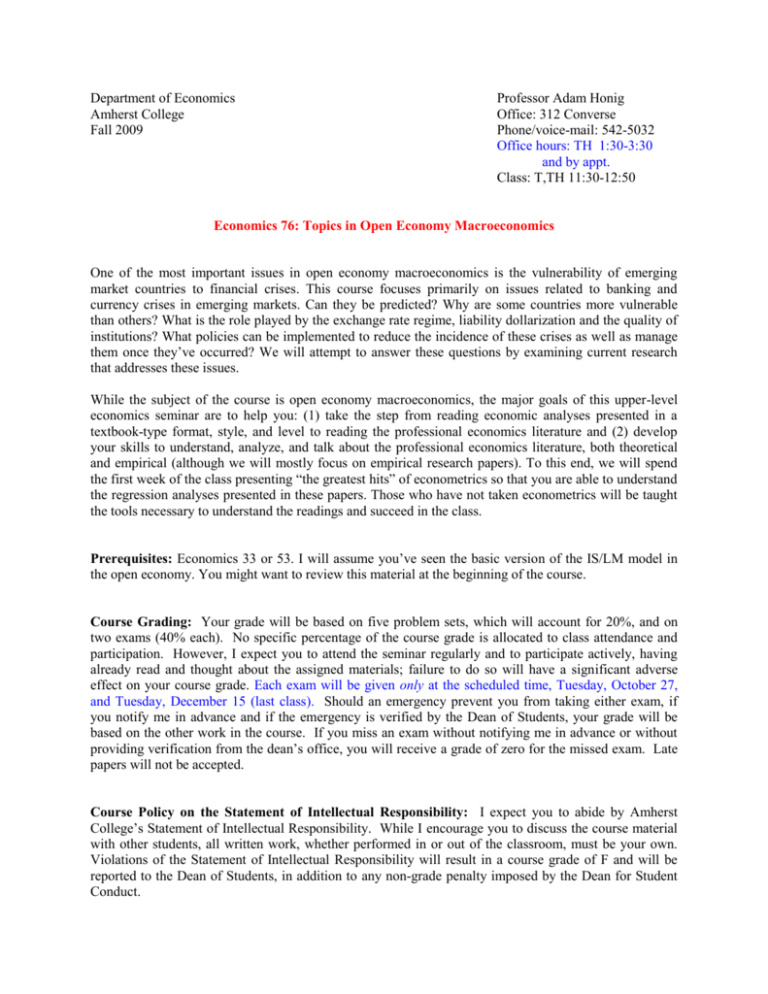
Department of Economics Amherst College Fall 2009 Professor Adam Honig Office: 312 Converse Phone/voice-mail: 542-5032 Office hours: TH 1:30-3:30 and by appt. Class: T,TH 11:30-12:50 Economics 76: Topics in Open Economy Macroeconomics One of the most important issues in open economy macroeconomics is the vulnerability of emerging market countries to financial crises. This course focuses primarily on issues related to banking and currency crises in emerging markets. Can they be predicted? Why are some countries more vulnerable than others? What is the role played by the exchange rate regime, liability dollarization and the quality of institutions? What policies can be implemented to reduce the incidence of these crises as well as manage them once they’ve occurred? We will attempt to answer these questions by examining current research that addresses these issues. While the subject of the course is open economy macroeconomics, the major goals of this upper-level economics seminar are to help you: (1) take the step from reading economic analyses presented in a textbook-type format, style, and level to reading the professional economics literature and (2) develop your skills to understand, analyze, and talk about the professional economics literature, both theoretical and empirical (although we will mostly focus on empirical research papers). To this end, we will spend the first week of the class presenting “the greatest hits” of econometrics so that you are able to understand the regression analyses presented in these papers. Those who have not taken econometrics will be taught the tools necessary to understand the readings and succeed in the class. Prerequisites: Economics 33 or 53. I will assume you’ve seen the basic version of the IS/LM model in the open economy. You might want to review this material at the beginning of the course. Course Grading: Your grade will be based on five problem sets, which will account for 20%, and on two exams (40% each). No specific percentage of the course grade is allocated to class attendance and participation. However, I expect you to attend the seminar regularly and to participate actively, having already read and thought about the assigned materials; failure to do so will have a significant adverse effect on your course grade. Each exam will be given only at the scheduled time, Tuesday, October 27, and Tuesday, December 15 (last class). Should an emergency prevent you from taking either exam, if you notify me in advance and if the emergency is verified by the Dean of Students, your grade will be based on the other work in the course. If you miss an exam without notifying me in advance or without providing verification from the dean’s office, you will receive a grade of zero for the missed exam. Late papers will not be accepted. Course Policy on the Statement of Intellectual Responsibility: I expect you to abide by Amherst College’s Statement of Intellectual Responsibility. While I encourage you to discuss the course material with other students, all written work, whether performed in or out of the classroom, must be your own. Violations of the Statement of Intellectual Responsibility will result in a course grade of F and will be reported to the Dean of Students, in addition to any non-grade penalty imposed by the Dean for Student Conduct. 2 Useful Reference Sources: (1) N. Gregory Mankiw, Macroeconomics, 6th or 7th edition. Chapter 5 and appendix to Chapter 12. (2) B. V. Yarbrough and R. M. Yarbrough, The World Economy: Trade and Finance, sixth edition, South-Western, 2003. (3) Economics 55 textbook (those who have taken econometrics will have used either Hill, Griffiths, and Judge or Pindyck and Rubinfeld) or another basic econometrics text. Other useful sources: DATA SOURCES include the World Bank, World Development Indicators, The International Monetary Fund, International Financial Statistics, both available on-line or at the reference desk. The World Bank and NBER also provide on-line access to other relevant datasets. JOURNALS that frequently publish relevant interesting work include the Journal of International Economics, International Economic Review, Journal of Money, Credit and Banking, Journal of International Money and Finance, Journal of Banking and Finance, World Bank Economic Review, Journal of Monetary Economics, Journal of Development Economics, and American Economic Review. ECONOMIC-RESEARCH GROUPS that regularly publish high-quality work on open economy macroeconomics include the National Bureau for Economic Research (www.nber.org), the World Bank (www.worldbank.org), and the IMF (www.imf.org). Both have searchable websites of their working papers. Online Journal Sources: http://www.amherst.edu/library/ - go to the “Journal” tab and search for the journal. Then search for the article. 2 3 Brief Outline of Course 1. Introduction to Econometrics 2. The Choice of Exchange Rate Regime 3. Financial Crises in Emerging Markets a) Background and Theory b) Predicting Currency and Banking Crises c) Managing and Preventing Crises - foreign bank entry in emerging markets 4. The Role of Institutions a) Background b) Do National Leaders Matter? c) Central Bank Independence d) Institutions and Volatility e) Liability Dollarization and Original Sin - Domestic Dollar Borrowing - Foreign Dollar Borrowing - Redemption from Original Sin f) Dollarization, Institutions and the Choice of Exchange Rate Regime g) Democracy and Economic Performance h) Improving Institutions 3 4 Detailed Course Outline (subject to change) – Required Readings are marked with an asterisk Week 1 – Intro to Course and Econometrics Tuesday – NO CLASS Thursday Week2 Tuesday * Statistics Background on course website (BLACKBOARD) Thursday * “Open Economy Model – Geof Woglom” on course website. This is the basic open economy model of a large open economy in the short run taught in EC 53 by me. The only difference is that instead of having an upward sloping LM curve in which the central bank targets the money supply, the central bank instead targets the interest rate so that there is a bar over the real interest rate r. Basically the LM curve is flat. But the ideas are basically the same and you won’t need to know the differences. We will do the upward sloping LM curve in class. * N. Gregory Mankiw, Macroeconomics - Appendix to Chapter 12 Week 3 Tuesday Problem Set 1 Due * Frankel, Jeffrey (1999) “No Single Currency Regime is Right for all Countries or at all Times” NBER Working Paper 7338 http://papers.nber.org/papers/w7338.pdf De la Torre, Augusto, Levy Yeyati, Eduardo and Sergio Schmukler, “Financial Globalization: Unequal Blessings” World Bank Working Paper 2903 http://econ.worldbank.org/files/20636_wps2903.pdf Thursday Week 4 Tuesday * Reading on academic literature on currency crises – BLACKBOARD Thursday *Mishkin, Frederic. (1996), “Understanding Financial Crises: A Developing Country Perspective,” in Michael Bruno and Boris Pleskovic, .eds, Annual World Bank Conference on Development Economics (World Bank, Washington D.C. 1996): 29-62. http://papers.nber.org/papers/w5600.pdf Don’t read section III or VI. *Kaminsky, Graciela and Carmen Reinhart (1999). “The Twin Crises: The Causes of Banking and Balance-of-Payments Problems,” American Economic Review, 89(3): 473-500. Read Introduction and Section 1a – pp 1-6 Library 4 5 Week 5 Tuesday *Kaminsky, Graciela and Carmen Reinhart (1999). “The Twin Crises: The Causes of Banking and Balance-of-Payments Problems,” American Economic Review, 89(3): 473-500. Read rest of paper. Thursday *Demirguc-Kunt, Asli, and Enrica Detragiache, (1998), “The Determinants of Banking Crises: Evidence from Developing and Developed Countries,” IMF Working Paper no. WP/97/106. http://www.imf.org/external/pubs/cat/longres.cfm?sk=2323.0 Week 6 Tuesday *Demirgüç-Kunt, Asli, and Enrica Detragiache, (2002), “Does Deposit Insurance Increase Banking Sector Stability: An Empirical Investigation,” Journal of Monetary Economics, Vol. 49, pp. 1373–406. Focus on section IV and section V.1. Library. Eichengreen, Barry and Andrew Rose, (1997), “Staying Afloat When the Wind Shifts: External Factors and Emerging-Market Banking Crises,” NBER Working Paper no. 6370. Eichengreen, Barry and Carlos Arteta, (2000), “Banking Crises in Emerging Markets: Presumptions and Evidence,” in Mario I. Blejer and Marko Skreb, eds., Financial Policies in Emerging Markets. Cambridge: MIT Press, 2002. Domaç, Ilker, and Maria Soledad Martinez Peria, (2000), “Banking Crises and Exchange Rate Regimes: Is There a Link?,” Journal of International Economics, Volume 61, Issue 1, October 2003, Pages 41-72 Frankel, Jeffrey and Andrew Rose (1996) “Currency Crashes in Emerging Markets: Empirical Indicators” NBER Working Paper no. 5437. Kaminsky, Graciela, Saul Lizondo and Carmen Reinhart (1997) “Leading Indicators of Currency Crises” IMF Working Paper No. 97/79. Kaminsky, Graciela (1999) “Currency and Banking Crises: The Early Warnings of Distress” IMF Working Paper No. 99/178. Sachs, Jeffrey, Aaron Tornell and Andres Velasco (1996) “Financial Crises in Emerging Markets: The Lessons From 1995”, Brookings Papers on Economic Activity, No. 1, pp. 147-215. Honig, Adam and Sonali Jain-Chandra (2006) “Micro-Level Evidence on the Role of Moral Hazard in the Asian Financial Crisis” Applied Econometrics and International Development, 6 (1). Thursday *Mishkin, Frederic, 2001, “Financial Policies and the Prevention of Financial Crises in Emerging Market Countries,” in Martin Feldstein (ed.), Economic and Financial Crises in Emerging Market Countries, University of Chicago Press, forthcoming. http://www.nber.org/papers/w8087 Just read sections 5 and 6 5 6 Week 7 Tuesday Problem Set 2 due *Dages, G., L. Goldberg, and D. Kinney, 2000, “Foreign and Domestic Bank Participation in Emerging Markets: Lessons from Mexico and Argentina” NBER working paper 7714. http://www.nber.org/papers/w7714 Stijn Claessens, Asli Demirgüç-Kunt, and Harry Huizinga (2001) “How Does Foreign Entry Affect the Domestic Banking Market?” Journal of Banking and Finance Volume 25, Issue 5, 891-911 Library Goldberg, L., 2001, “When is U.S. Bank Lending to Emerging Markets Volatile?,” Federal Reserve Bank of New York, Mimeo. Jennifer S. Crystal, B. Gerard Dages and Linda S. Goldberg (2001) “Does Foreign Ownership Contribute to Sounder Banks in Emerging Markets? The Latin American Experience” Federal Reserve Bank of New York Thursday *Jones, Benjamin and Benjamin Olken (2004) “Do Leaders Matter? National Leadership and Growth Since World War II” http://papers.ssrn.com/sol3/Delivery.cfm/SSRN_ID524042_code268708.pdf?abstractid=524042&mirid= 1 (if this doesn’t work, go to SSRN.com and search for the authors’ names) *Economist Article on Africa and Institutions Week 8 Tuesday – MIDTERM 1 Thursday IMF World Economic Outlook April 2003 Chapter 3 http://www.imf.org/external/pubs/ft/weo/2003/01/pdf/chapter3.pdf World Bank World Development Report September 2002 - Chapter 1, Chapter 3-section 5 on Political Institutions and Governance http://econ.worldbank.org/wdr/WDR2002/text-2394/ Barro, R. and D. Gordon (1983), “A Positive Theory of Monetary Policy in a Natural Rate Model,” The Journal of Political Economy, Volume 91, Issue 4 (Aug., 1983), 589-610. Library Week 9 Tuesday Thursday *Alex Cukierman, Steven B. Webb, and Bilin Neyapti (1992) “Measuring the Independence of Central Banks and Its Effect on Policy Outcomes” The World Bank Economic Review Volume 6, Number 3. Library Alesina, Alberto and Lawrence Summers (1993) “Central Bank Independence and Macro Performance: Some Comparative Evidence” Journal of Money, Credit and Banking, Volume 25, Issue 2, 151-162. Library Sturm, Jan-Egbert and Jakob de Haan (2001) “Inflation in developing countries: does central bank independence matter? New evidence based on a new data set” mimeo 6 7 Week 10 Tuesday *Acemoglu, Daron, Simon Johnson and James A. Robinson (2001) “Colonial Origins of Comparative Development: An Empirical Investigation,” American Economic Review, Volume 91, Issue 5, 1369-1401. Library Thursday Problem set 3 due Acemoglu, Daron, Simon Johnson, James A. Robinson and Yunyong Thaicharoen (2003). “Institutional Causes, Macroeconomic Symptoms: Volatility, Crises and Growth,” Journal of Monetary Economics (Carnegie-Rochester Conference Series), forthcoming. http://www.nber.org/papers/w9124 Easterly and Levine: 2002 “Tropics, Germs and Crops: How Endowments Influence Economic Development”. NBER Working Paper 9106. http://www.nber.org/papers/w9106 Week 11 Tuesday *Honig, Adam (2009), “Dollarization, Exchange Rate Regimes and Government Quality.” Journal of International Money and Finance, 8:2, 198-214. Library Reinhart, C., Rogoff, K., and M. Savastano (2003), “Addicted to Dollars,” NBER Working Paper w10015. http://papers.nber.org/papers/w10015.pdf Calvo, G., and C. Végh (1992), “Currency Substitution in Developing Countries: An Introduction,” Revista de Analisis Economico ,. pp. 3-27. Thursday Problem set 4 due *Hausmann, R., and U. Panizza (2003), “The Determinants of Original Sin: An Empirical Investigation,” Journal of International Money and Finance, Volume 22 (2003) 957-990. Library Ignore discussion on domestic original sin. Eichengreen, B., R. Hausmann, and U. Panizza (2002), “Original Sin: The Pain, the Mystery and the Road to Redemption,” Paper prepared for the conference “Currency and Maturity Matchmaking: Redeeming Debt from Original Sin,” Inter-American Development Bank, Washington, D.C., 21-22 November 2002. 7 8 THANKSGIVING BREAK Week 12 Tuesday Burger, J. and F. Warnock (2003), “Diversification, Original Sin, and International Bond Portfolios,” International Finance Discussion Papers 755. Washington: Board of Governors of the Federal Reserve System, 2003. http://www.federalreserve.gov/pubs/ifdp/2003/755/default.htm Eichengreen, B., R. Hausmann, and U. Panizza (2002), “Original Sin: The Pain, the Mystery and the Road to Redemption,” Paper prepared for the conference “Currency and Maturity Matchmaking: Redeeming Debt from Original Sin,” Inter-American Development Bank, Washington, D.C., 21-22 November 2002. Calvo, Guillermo and Carmen Reinhart (2002) “Fear of Floating” Quarterly Journal of Economics 117:2, pg. 379 Library Hausmann, R., Panizza, U., and E. Stein, 2001. Why do countries Float the way they Float? Journal of Development Economics 66 (2), 387–414. Don’t read the appendix. Library Thursday Alesina, Alberto and Alexander Wagner (2004) “Choosing (and Reneging) on Exchange Rate Regimes” http://papers.ssrn.com/sol3/papers.cfm?abstract_id=431680 Honig, Adam “Fear of Floating and Domestic Liability Dollarization,” Emerging Markets Review, Volume 6, Issue 3, September 2005, Pages 289-307. * Robert I. Barro 1994 “Democracy and Growth” http://www.nber.org/papers/w4909 In terms of the empirical analysis, focus on table 1 and the effect of democracy. Dani Rodrik 1997 “Democracy and Economic Performance” WEEK 13 Tuesday Problem set 5due *Roumeen Islam, Claudio E. Montenegro 2002 “What Determines the Quality of Institutions?” Background Paper for the World Development Report 2002: Building Institutions for Markets. *Wei, Shang-Jin, 2000. “Natural Openness and Good Government”. NBER 7765. http://www.nber.org/papers/w7765 Just read section 1,3,4. Section 2 is optional. WEO April 2003 section on Institutional Reform in Practice pp. 17-25. Thursday Week 14 Tuesday - MIDTERM 2 8
